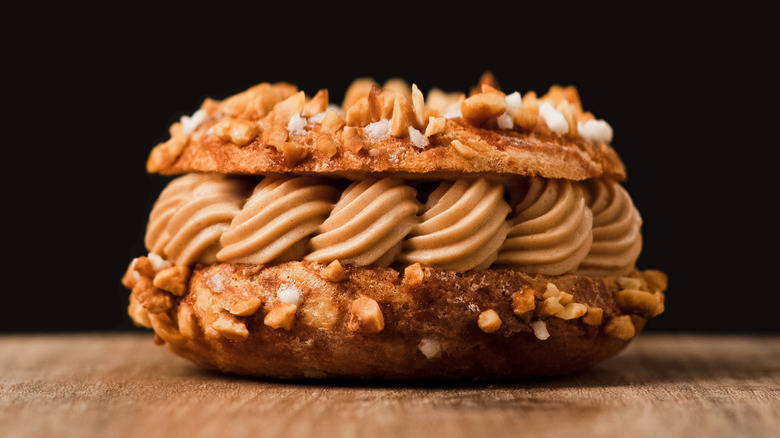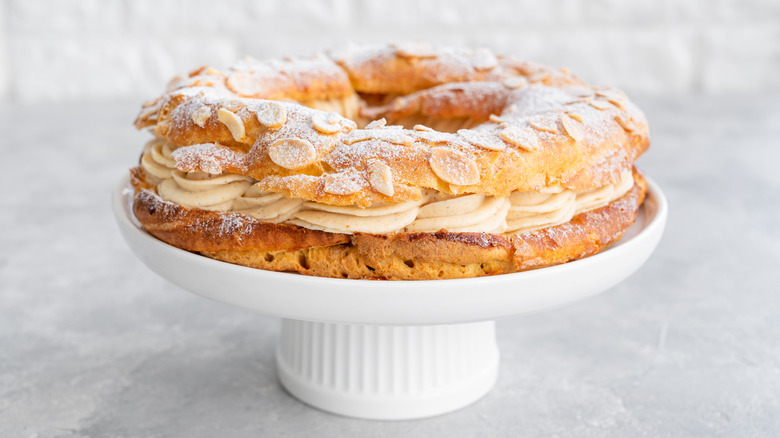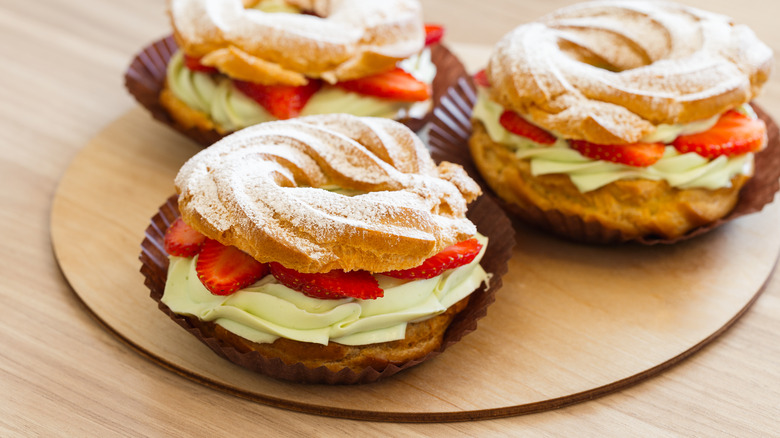Paris-Brest: The Intricate French Pastry Inspired By A Bicycle Race
Pastry, whether it be the thin golden phyllo dough so popular in Greek and Turkish desserts or the rough and puff pastry used in both sweet and savory dishes further north, is always considered a culinary delicacy. Perhaps it's because of its inherently temperamental nature, or maybe it's because pastries are so commonly made into the richest and most succulent recipes recorded. Regardless of the reason, pastry has been used and revived in many different forms since its invention.
According to Macmillan Dictionary Blog, it is widely believed that the Egyptians were the first people to create dishes that we might recognize as pastries. In fact, the Egyptians are not only believed to be the creators of pastry but also of the widely-beloved sourdough.
The first pastry was likely a simple mixture of flour and water, but as the method was shared through the Middle East and Europe, fat and other ingredients were added until eventually multiple different forms of pastry were born. Just one of the many varieties that developed in the years that followed was the pâte à choux, which is at the heart of the infamous French dessert called the Paris-Brest.
History of the Paris-Brest
The French are well known for their architectural feats like the Eiffel Tower, the palace of Versailles, and the Louvre. They are also world-renowned for being the beating heart of traditional winemaking and have some of the most mouth-watering and expensive bottles of wine in the world. The country also hosts its share of bicycle races, such as the iconic Tour de France, and France is highly appreciated for its high-quality pastries including the croissant, macaron, and madeleines. Though it may seem a bit funny at first, the French people blended their love of bicycling and pastry-making into a delicious racing-themed dessert: the Paris-Brest.
According to the Joy of Baking, the Paris-Brest is named after a 1,200-kilometer bicycle race that takes place once every four years. As you may have guessed, the race takes riders from Paris to Brest, France, and it is a tradition that began in 1891 that continues to this day.
The New York Times reports that this sport-inspired pastry was invented by chef Louis Durand in 1910. Durand wanted to honor the famous race, and to do so he created a choux-based sweet that was shaped into a wheel and filled with a sweet, nutty-flavored filling. Since its conception, the Paris-Brest has been the honorary dessert of the Paris-Brest bicycle race and makes for a delectable and visually stunning dish best prepared for groups of people who you really want to spoil.
How is it made?
The Paris-Brest pastry is not as simple as whipping up a cake or your favorite cookie recipe. It is a layered and multi-step process to create together this French delicacy. Still, in the end it is totally worth the extra effort.
A golden and fluffy choux pastry is baked into a perfect circle — to represent a bicycle wheel, of course. The pastry is then enhanced by a sweetening element: the Crème Mousseline (via Spatula Desserts). If you've ever had a cream-filled éclair, you'll have a better grasp of how this particular dessert is supposed to be constructed. An éclair and the Paris-Brest are both made with choux, which, according to the Food Crumbles, is a light and delicate dough. Mixed together on the stove and then baked until it forms a stiff pastry shell, the choux should be incredibly light and taste a bit like an egg, but not overwhelmingly so. It is rather plain in and of itself, but that is why the filling and a topping of shaved almonds are added.
The Paris-Brest is traditionally flavored with nuts, the most popular being hazelnut. However, it can also be made using almonds, pistachio, pecans, chocolate, or other flavor combinations. The Scran Line explains that after the choux pastry has been successfully made, dried, and halved horizontally, it is time to fill it with the pastry cream. The cream should be thick, sweet, flavored with praline paste, and then piped between the layers of pastry in large, attractive swirls. This filling is then carefully topped with the second layer of choux.


